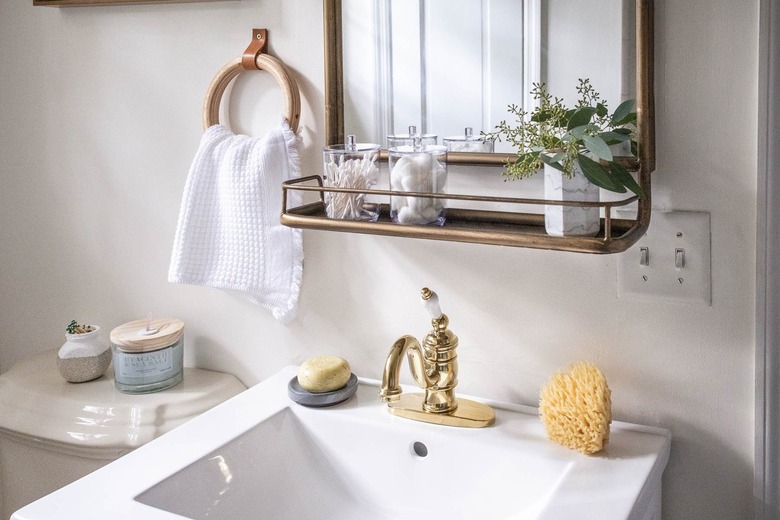How To Clean Black Sludge In Bathroom Sink Drains
We may receive a commission on purchases made from links.
Slow-running drains, tiny fluttering flies, a nasty smell, and/or black sludge — all are indications of bio slime in a sink drain. Over time, a combination of phlegm, toothpaste, soap residue, hair, and other debris builds up inside the pipes. Whether they are PVC, copper, or cast iron pipes, there are several ways to clear the sludge and resolve your bathroom sink issues.
Unclogging Your Drains
Unclogging Your Drains
While liquids and gels formulated to break up clogs are an option, if you have old pipes or a septic system, the harsh chemicals will do your plumbing no good. Instead of commercially produced clog-removing products, you can try using a variety of household products. The classic method uses boiling water and 1 cup each of baking soda and vinegar:
- Remove the drain stopper by unscrewing it or by removing the nut and retaining rod under the sink.
- Pour 1/2 gallon of boiling water down the drain.
- Plug the sink air vent with a rag.
- Add 1 cup of baking soda to the drain and wait a couple of minutes.
- Pour 1 cup of vinegar into the drain.
- Cover the drain with a rubber stopper and weigh it down to form a seal.
- Wait one hour.
- Rinse the drain with another 1/2 gallon of boiling water.
Alternatives to baking soda and vinegar include using 1 cup of cream of tartar or a mixture of 1/4 cup of salt, 1/4 cup of baking soda, and 1 teaspoon of cream of tartar. Pour it into the drain and allow it to soak in for 15 minutes. Then, follow with 1/2 gallon of boiling water.
Clear Clogs Manually
Clear Clogs Manually
Drain snakes are made specifically to unclog sinks. Push the snake into the drain. When it won't go any further, turn the handle clockwise until the clog releases and then continue pushing the snake through the pipes. Pull it back out slowly; it will also pull out the clogs and gunk as you remove it from the pipe.
You can also use a plunger to dislodge clogs. Simply plug the vent hole in the sink, fill the sink half full with water, and then plunge until the sink begins to drain. Use paper towels or rags to wipe out the black gunk and sludge that is pulled out by the suction of the plunger; don't let it go back down the drain.
Removing Bio Slime in a Sink Drain
Removing Bio Slime in a Sink Drain
Bio slime clings to the sides of the pipes and even when the clog is gone, the decaying organic matter is still there. Drain flies lay their eggs, and the larvae thrive in the bio slime, emerging as tiny, fluttering, mothlike flies.
You can use manual methods to clear the drains and scrub the inside of the pipes. These methods also help clear black sludge in a shower drain and floor drains. To remove hair and gunk:
- Use a drain cleaning tool like a Zip-It. This flexible plastic tool with tiny barbs allows you to insert it into the drain and slowly pull out the hair clogs and gunk.
- Pour dishwashing liquid on a long, slender drain brush tool.
- Insert the brush into the drain and scrub the interior of the pipes.
- Rinse and repeat.
Clean all of your tools with dishwashing liquid and hot water. Allow them to dry completely before storing them in a cabinet, the laundry room, or the garage.
Preventing Drain Clogs and Sludge
Preventing Drain Clogs and Sludge
You may wonder: Is the black sludge in sinks dangerous? The bio slime in the pipes may contain harmful bacteria as well as flies and their larvae. Floor drains may harbor cockroaches and other bugs that spread germs.
Help prevent clogs and sludge with regular maintenance. One eco-friendly solution is using Simple Green every two to four weeks. Before going to bed at night:
- Pour 1/2 gallon of boiling water slowly into the drain.
- Wait five minutes and then run the cold water.
- Use a Zip-It or similar tool to remove hair and debris.
- Pour 2 cups of Simple Green down the drain.
- Wait until morning and then run hot water to rinse the Simple Green out of the pipes.
To keep drains clear, use hair strainers to keep hair out of the pipes. When shaving, don't rinse hair down the sink; instead, wipe it up. Short or long, once hair catches in a drain, it begins slowing the flow of water and organic matter and provides a breeding ground for that black gunk in water pipes.
